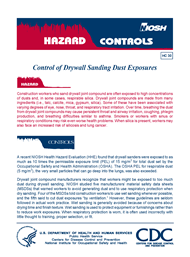Control of Drywall Sanding Dust Exposures
June 1999
DHHS (NIOSH) Publication Number 99-113

Hazard
Construction workers who sand drywall joint compound are often exposed to high concentrations of dusts and, in some cases, respirable silica. Drywall joint compounds are made from many ingredients (i.e., talc, calcite, mica, gypsum, silica). Some of these have been associated with varying degrees of eye, nose, throat, and respiratory tract irritation. Over time, breathing the dust from drywall joint compounds may cause persistent throat and airway irritation, coughing, phlegm production, and breathing difficulties similar to asthma. Smokers or workers with sinus or respiratory conditions may risk even worse health problems. When silica is present, workers may also face an increased risk of silicosis and lung cancer.
Controls
A recent NIOSH Health Hazard Evaluation (HHE) found that drywall sanders were exposed to as much as 10 times the permissible exposure limit (PEL) of 15 mg/m3 for total dust set by the Occupational Safety and Health Administration (OSHA). The OSHA PEL for respirable dust (5 mg/m3), the very small particles that can go deep into the lungs, was also exceeded.
Drywall joint compound manufacturers recognize that workers might be exposed to too much dust during drywall sanding. NIOSH studied five manufacturers material safety data sheets (MSDSs) that warned workers to avoid generating dust and to use respiratory protection when dry sanding. Four of the MSDSs told construction workers to use wet sanding whenever possible, and the fifth said to cut dust exposures by ventilation. However, these guidelines are seldom followed in actual work practice. Wet sanding is generally avoided because of concerns about drying time and finish texture. Wet sanding is used to protect equipment or furnishings rather than to reduce work exposures. When respiratory protection is worn, it is often used incorrectly with little thought to training, proper selection, or fit.
Vacuum Sanding Systems
Several light-weight sanding systems are now sold to control drywall workers sanding exposures (see Figure 1). These systems use portable vacuums to capture and remove the dust before the worker is exposed to it. In 1994, NIOSH studied several of these sanding systems at the International Brotherhood of Painters and Allied Trades (IBPAT) Apprenticeship Training Facility in Seattle, Washington. NIOSH engineers compared the dust exposures from three pole-sanding and two hand-sanding vacuum control systems with the exposures from traditional, nonventilated sanding methods. The five commercially available vacuum sanding controls successfully reduced dust exposures by 80% to 97%. Four of the five sanding controls cut exposures by nearly 95%. If engineering controls had reduced total dust exposures by 90% in the HHE case report described earlier, the construction workers exposures would have remained below the OSHA PEL.
Since the 1994 NIOSH study, more manufacturers are now making drywall sanding controls to cut dust exposures. Although NIOSH has not tested these controls, researchers expect them to per- form well. In addition to cutting dust exposures, each of these new controls has its own special features that will attract both drywall professionals and the do-it-yourselfer.
In addition to lower exposures, vacuum sanding systems can help the sander, subcontractor, general contractor, and building owner in other ways. The dramatic reduction in airborne dust exposures results in a much cleaner work area during and after sanding. For workers, the clean working environment is more comfortable; less irritating to eyes, nose, and throat; and less likely to require respiratory protection. For the subcontractor, a comfortable worker is likely to be more productive, be absent less often, and require fewer breaks for fresh air. The savings and reduced regulatory liability given by lower respiratory protection requirements will be passed from the subcontractor to the building owner. Other cost savings will result from a cleaner environment that reduces dirt, cleanup time, and repair or repainting of stained floors and carpets.
Pole-Sanding
NIOSH study results suggest that the construction workers dust exposures might be cut simply by changing from hand-sanding to pole-sanding. This change is even more important when working overhead. The pole increases the space between the worker and the sanding surface, which in turn reduces the amount of dust close to the workers nose and mouth.
For More Information
To obtain more free information about controlling this hazard or for information about other occupational health and safety issues:
Call NIOSH at
1-800-35-NIOSH (1-800-356-4674), or
Visit the NIOSH Homepage
The NIOSH report HETA 94–0078–2660 and a list of known sources for drywall sanding engineering controls may be requested from NIOSH. A drywall sanding kit may be requested from the Center to Protect Workers Rights (202–962–8490).
NIOSH is the Federal agency responsible for conducting research and making recommendations for preventing work-related illnesses and injuries. All HAZARD CONTROLS are based on research studies that show how worker exposures to hazardous agents or activities can be significantly reduced.
Acknowledgments
The principal contributors to this publication were Kenneth R. Mead, P.E.; Aubrey K. Miller, M.D.; and Jerome P. Flesch, M.S. Desktop publishing was provided by Vanessa Becks, Kristina Dragon, and Susan Kaelin.
This document is in the public domain and may be freely copied or reprinted. NIOSH encourages all readers of this HAZARD CONTROLS to make it available to all interested employers and workers.
